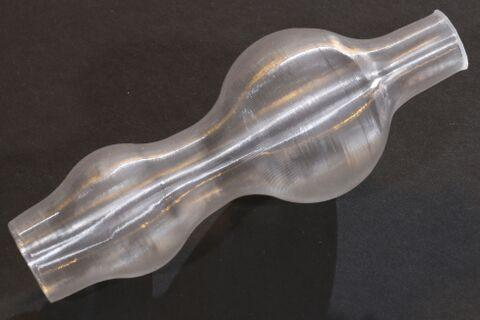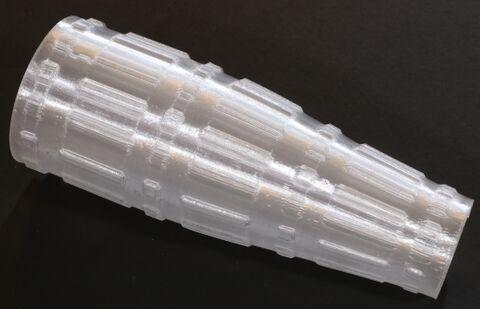taulman 3D Works with DuPont Packaging & Industrial Polymers to Develop ‘T-lyne,’ a Significant Advancement in Flexible Materials for 3D Printing using DuPont Surlyn ionomer
 If you want to get validation for a project in creating a new material or chemical, having the name DuPont attached to it is a pretty good bet. Built on science–and a heritage of over 200 years that most of us are well-aware of–DuPont is synonymous with innovative new products and patents in the areas of new materials and chemicals, as well as being a global presence.
If you want to get validation for a project in creating a new material or chemical, having the name DuPont attached to it is a pretty good bet. Built on science–and a heritage of over 200 years that most of us are well-aware of–DuPont is synonymous with innovative new products and patents in the areas of new materials and chemicals, as well as being a global presence.
Now, in working with DuPont, the taulman 3D team points out that this collaboration in the creating of new 3D printing materials is highly significant in that one of the world’s largest chemical companies is not only just interested in the development of the a new filament, but that they are recognizing the importance of 3D printing altogether.
“DuPont selected taulman 3D to help develop and move forward in releasing new materials to the 3D printing community, and we now have an excellent working relationship with both major materials divisions at DuPont,” Tom Martzall, founder of taulman 3D, told 3DPrint.com. “The name ‘DuPont’ should capture eyes worldwide.”
 In an ongoing project since July of 2015, both DuPont and taulman 3D have been collaborating to create a new and flexible material that would not only lead to easy 3D printing but would also, very importantly, adhere to nearly any print bed. According to the taulman 3D team, more work has gone into the development of this material than any other they’ve made to date, with the exception of Alloy 910.
In an ongoing project since July of 2015, both DuPont and taulman 3D have been collaborating to create a new and flexible material that would not only lead to easy 3D printing but would also, very importantly, adhere to nearly any print bed. According to the taulman 3D team, more work has gone into the development of this material than any other they’ve made to date, with the exception of Alloy 910.
The new material, T-lyne, uses the DuPont Surlyn ionomer, and is a completely unique, crystal clear polyethylene copolymer developed specifically for high durability, flexibility, unique viscosity, and a wide temperature range.
“Glass-like aesthetics can easily be obtained at high layer sizes using low speed and low temperatures in the range of 190 to 210 degrees celsius. Utility style parts are easily printed faster at standard layer sizes using higher temperatures up to 245 C, depending on nozzle size,” states the taulman team.
The DuPont Surlyn in T-lyne meets FDA 21CFR 177.1330(a) and it’s very important to note for the purposes of 3D printing–and especially within the medical device industry–that it can potentially be used in the 3D printing of prosthetics. One of the most unique features of this new material is that a part can be dipped into hot water so that minor adjustments can be made. The part can then be cooled, and it will retain its shape rather than reverting.
“For years, clinics have used polyethylene braces, temporary casts, and corrective positioning components to more closely match the end user’s exact needs. The clarity of T-lyne allows one to see into or through a part with as many as five to eight perimeters, and determine where adjustments may be needed,” states the taulman 3D team. “This same clarity is used for non-destructive evaluation of any printed utility part as internal adhesion is paramount. Also, T-lyne has a surface that is not slippery, making hand tools made from T-lyne unlikely to slip out of one’s hand.”
 T-lyne offers incredible strength and resistance, with even a small perimeter of the material being able to withstand a huge impact. Surlyn is even used to coat golf balls and bowling pins for protection against the elements and extreme abuse. It also offers very uniform color ability when required.
T-lyne offers incredible strength and resistance, with even a small perimeter of the material being able to withstand a huge impact. Surlyn is even used to coat golf balls and bowling pins for protection against the elements and extreme abuse. It also offers very uniform color ability when required.
Specifications:
Physical Nominal Values Test Method
Density 0.97g/cm³ ASTM D792 – ISO 1183
Melt Flow Rate (Condition E, 2.16kg) 4.5g/10 min ASTM D1238 – ISO 1133
Thermal Nominal Values Test Method
Brittle Temperature not yet determined ASTM D746
Melting Point (DSC) 183°F (84°C) ASTM D3418 – ISO 3146
Vicat Softening Point (Rate B) 127°F (53°C) ASTM D1525 – ISO 306
Freezing Point (DSC) 104°F (40°C) ASTM D3418
Mechanical Nominal Values Test Method
Abrasion Resistance 301NBS Index ASTM D1630
Flexural Modulus (73°F) 490MPa (71068psi) ASTM D790
Flexural Modulus (-4°F) not yet determined ASTM D790
Ross Flex (-20°F) not yet determined ASTM D1052
Tensile Elongation @ Break (73°F) 320% ASTM D638 – ISO 527-2
Tensile Strength @ Break (73°F) 31MPa (4496psi) ASTM D638 – ISO 527-2
Tensile Strength @ Yield (Type IV bars,
compression molded, 5.0 cm/min, 73 °F)
18.6MPa (2698psi) ASTM D638
Impact Nominal Values Test Method
Notched Izod Impact (73 °F) not yet determined ASTM D256
Tensile Impact Strength (73 °F) 427ft-lb/in² ASTM D1822
Tensile Impact Strength (-40 °F) not yet determined ASTM D1822
Hardness Nominal Values Test Method
Durometer Hardness (Shore D) 65 ASTM D2240 – ISO 868
Optical Nominal Values Test Method
Haze (0.250 in) 1.3% ASTM D1003
Elastomer Nominal Values Test Method
Tear Strength (73°F) not yet determined ASTM D624
In the development of making the Surlyn isomer for 3D printing, the taulman 3D team worked with David D. Zhang of DuPont, who they states was significant in defining and isolating the best polymers for the creation of T-lyne.
T-lyne prints easily on cold and warm (40°C) surfaces, such as clean glass, PEI, Ultem, Borosilicate glass, acrylic, BuildTak, GeckoTek and others.
Subscribe to Our Email Newsletter
Stay up-to-date on all the latest news from the 3D printing industry and receive information and offers from third party vendors.
You May Also Like
3D Printing News Briefs, April 13, 2024: Robotics, Orthotics, & Hypersonics
In 3D Printing News Briefs today, we’re focusing first on robotics, as Carnegie Mellon University’s new Robotics Innovation Center will house several community outreach programs, and Ugogo3D is now working...
Rail Giant Alstom Saves $15M with 3D Printing Automation Software 3D Spark
3D Spark has entered into a three-year deal with the rail giant Alstom. Alstom, a transport behemoth with annual revenues of $16 billion, specializes in the manufacture of trains, trams,...
Meltio Expands Global Reach with New Partnerships in the Americas and Europe
Spanish 3D printing manufacturer Meltio has expanded its sales network across the globe. With the addition of three new partners in the United States, Brazil, Argentina, and Italy, Meltio aims...
3D Printing Webinar and Event Roundup: April 7, 2024
Webinars and events in the 3D printing industry are picking back up this week! Sea-Air-Space is coming to Maryland, and SAE International is sponsoring a 3D Systems webinar about 3D...
































